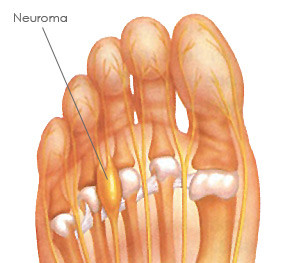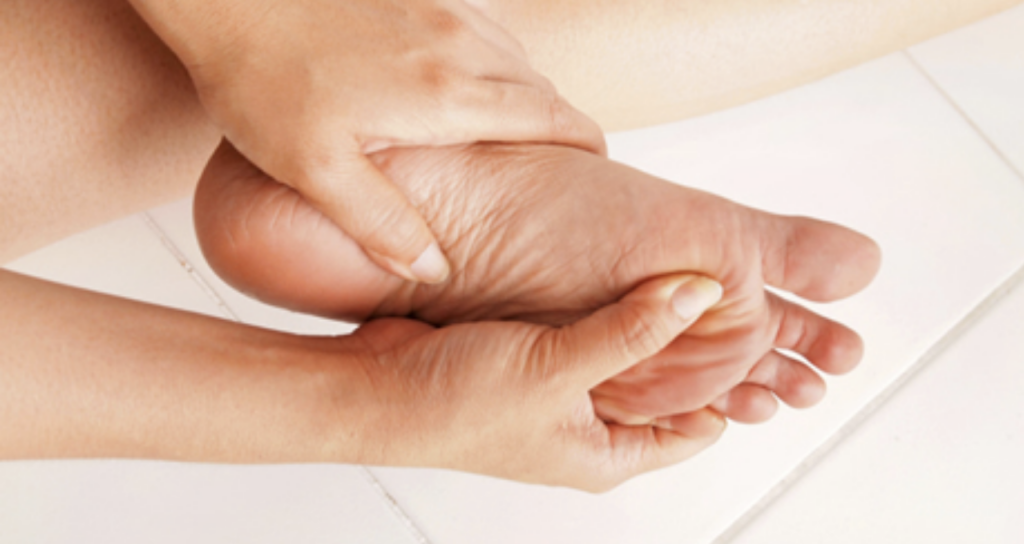How to Identify and Treat Morton’s Neuroma
It’s no longer treated by amputation, but those who have experienced the pain can probably understand why it was. The pain and annoyance of a Morton’s Neuroma can bring the most ambitious athlete to a halt and is the bane of millions of people who work on their feet.
A Morton’s Neuroma is an injury to any of the nerves that pass through the ball of the foot and into the lesser toes. These nerves pass through the narrow space between the metatarsal heads (the bones that form the ball of the foot). This passageway is closed in on the bottom by a tough ligament, so the nerves are vulnerable to being crushed in this small space.
The injury starts when the nerve becomes inflamed and swollen due to compression, stretching, and rubbing between the bones. If it’s caught and treated early, no permanent damage occurs. If left to continue, though, fibrous scar tissue builds up around the nerve to the point of choking its function entirely. This mass of fibrous tissue around the nerve is the neuroma.
Typical Symptoms of a Morton’s Neuroma

There are several conditions with similar symptoms. If this pain sounds familiar, see your family physician so they can properly diagnose it. Many cases can be diagnosed in your doctor’s office, but some may need to be confirmed by ultrasound or MRI.
1. A small point of sharp pain in the ball of the foot.
2. Feeling a lump under the ball of the foot, sometimes accompanied by a clicking sensation.
3. Nerve symptoms in the toes served by the nerve, such as numbness, tingling, or burning.
These symptoms are usually worse in shoes than in sandals or barefoot, and much worse in tight or high-heeled shoes. Footwear is the strongest risk factor for developing a Morton’s Neuroma; women who regularly wear high-heeled shoes are nearly 10 times more likely to develop the injury than the general population.
Certain gait patterns, like toeing off incorrectly, can also contribute to this injury. Anatomy plays a major role as well; feet with flat transverse metatarsal arches (flat across the front of the foot) have less space between the metatarsal heads, to begin with.
To adequately address the forces causing the injury, book an assessment by a Canadian Certified Pedorthist at Kintec. They will identify what forces are contributing to the injury, and treat them accordingly.
Morton’s Neuroma Treatments Options
If the diagnosis is Morton’s Neuroma, then conservative, non-invasive treatment is the best place to start. Applying ice to the top and bottom of the ball of the foot (no more than 10 minutes at a time, less if discomfort occurs) can help to relieve symptoms immediately by reducing swelling and compression.
1. Properly fitted footwear to reduce overall compression.
2. Rocker-soled shoes to reduce weight-bearing pressure during toe-off.
3. Metatarsal pads to lift and spread the metatarsal heads and make more room for the nerve.
4. Custom foot orthotics to correct gait patterns, distribute pressure and de-compress the space between the metatarsal heads.
5. Physiotherapy is a good complementary treatment. Physiotherapists can use mobilizations and inflammation control therapies to aid in healing.
Some severe cases may not respond to conservative treatment. Over time, the fibrous tissue around the nerve can build up to the point that it is permanently compressed. In these cases, more invasive treatments like corticosteroid injection or even surgery may be required. In these relatively rare cases, conservative care should continue after recovery from surgery to prevent it from coming back.
When Dr. Morton first described this neuroma in 1876, most patients had access to limited treatments and had to just put up with the pain. Now there are many treatments available, so there is no need to just live with it. If you have pain or numbness in the toes and balls of your feet, see a specialist – no amputations necessary.
Ben Boyer
Pedorthist and Kintec Lab Manager



No Comments